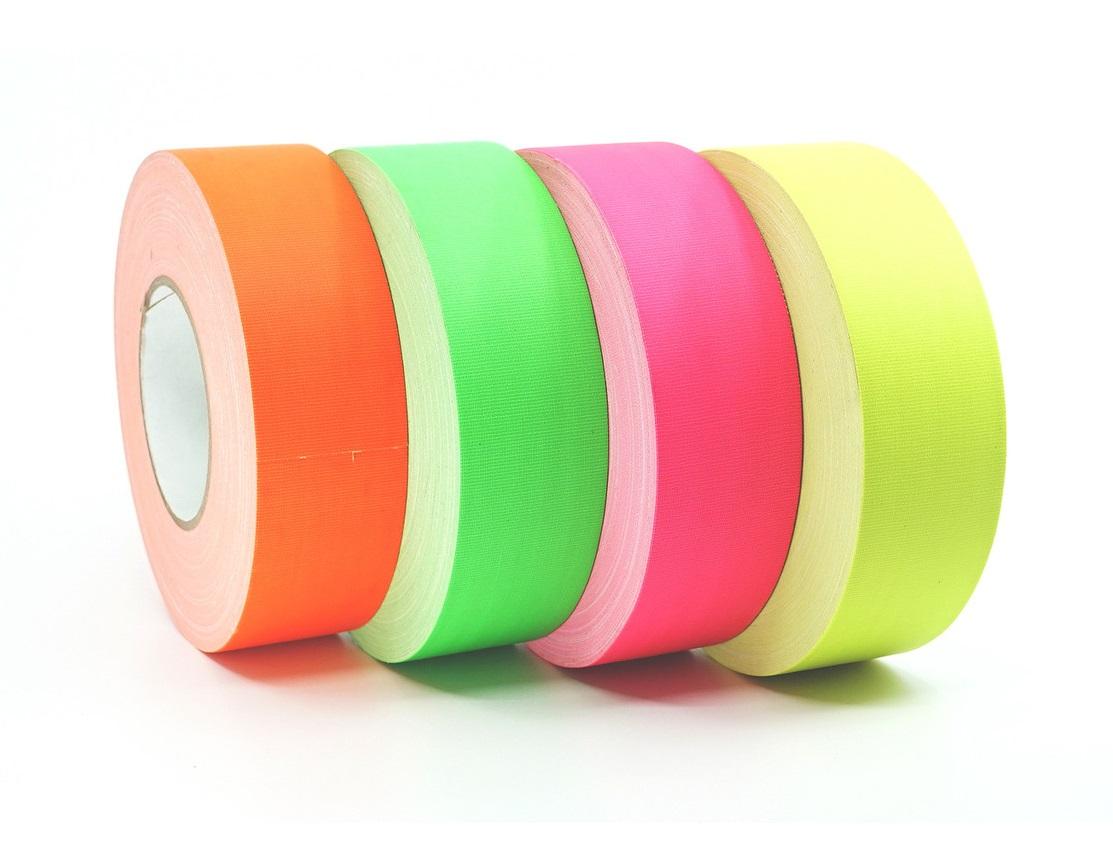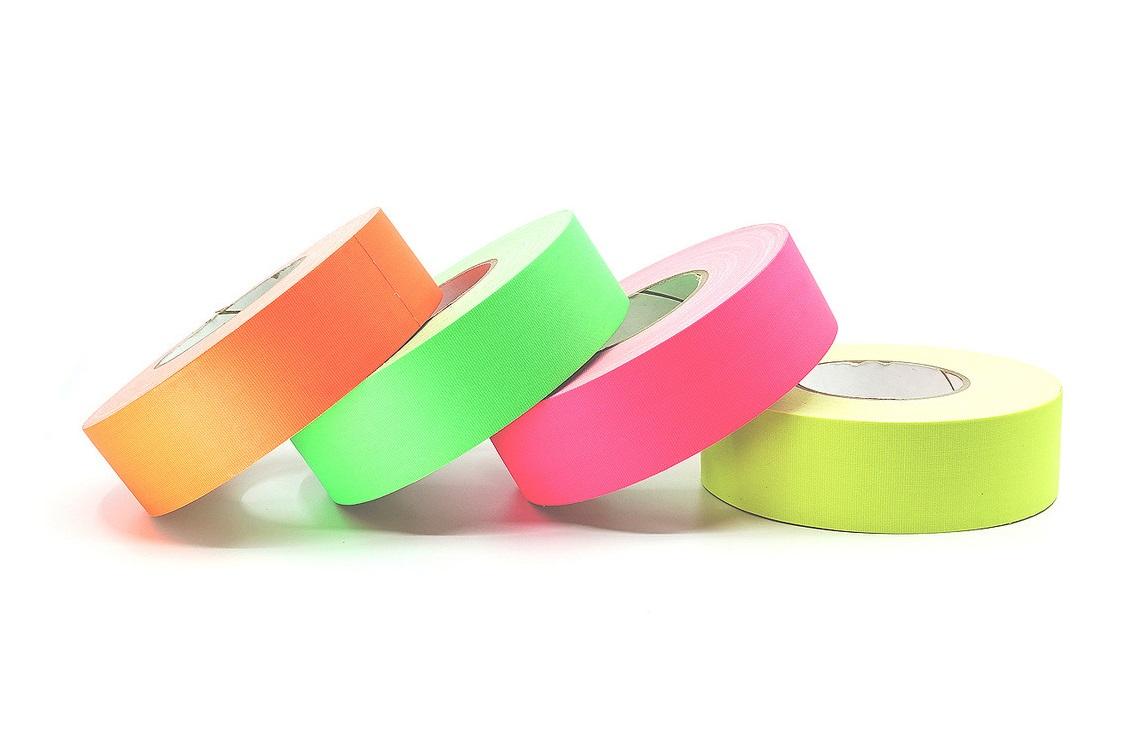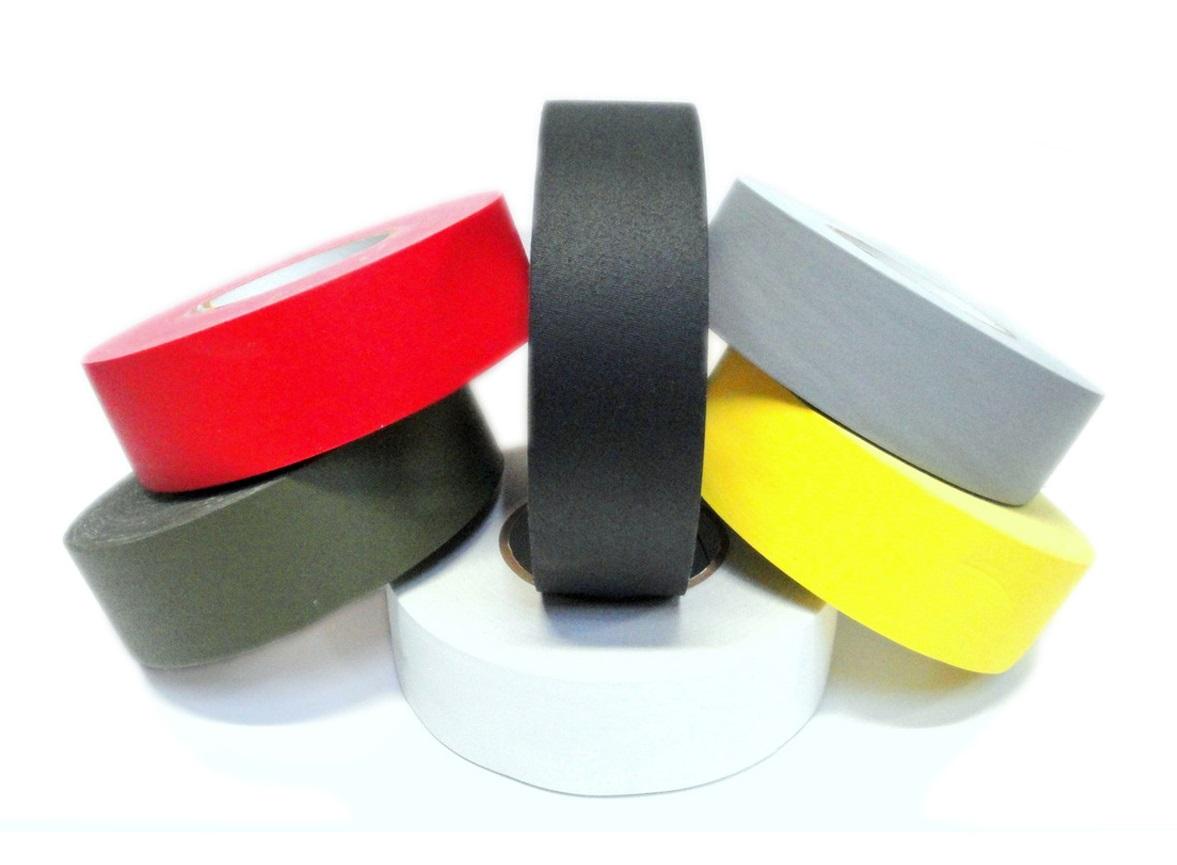The Complete Guide to Gaffer Tape
Gaffer tape, also commonly referred to as gaff tape or gaffer's tape, is a durable cloth tape with a low-residue natural adhesive. Though it was originally designed for electrical professionals and entertainment, film, television, and theater production lighting, gaffer tape can be used for all sorts of projects and in many industries.
Before buying gaffer tape, it's important to know what kinds are available and how to use it.
What Is Gaffer Tape?
A gaffer is the chief lighting and electrical technician who works on theater, TV, and film sets. These professionals needed non-reflective tape to secure cords, wires, and various other parts of a stage or set.
Workers on stage and in a production crew also needed to mark, or "spike," where an actor or musician should stand on the set. Since these were temporary placements, the ideal tape would be easy to remove and would not leave behind a sticky residue. So, in 1959, gaffer/spike tape was invented and has been used in the film and entertainment industry ever since.
Gaffer tape can be used on many different types of surfaces and in a wide range of temperatures. Standard-grade gaffer tape can withstand minus 31 to 176 degrees Fahrenheit.
Gaffer tape is made with a cloth backing that is more durable than tapes made entirely of plastic. It's also non-reflective, making it a great tape for photographers and filmmakers. The natural rubber adhesive is strong enough to tie cords together and tape items temporarily but not so strong that it will adhere to the surface permanently.
Gaffer Tape Versus Duct Tape
You can think of gaffer tape as duct tape's quiet cousin. They are both durable cloth-backed tapes that may be used for interior or exterior applications. In contrast to duct tape, which is known for its strength, gaffer tape is useful in more delicate situations and offers a more gentle touch.
The natural rubber adhesive tends to be less strong than the adhesive used on duct tape. This lack of adhesive strength isn't a bad thing. It's one of the reasons gaffer tape is popular — the tape is well-suited to temporary uses and will not leave any residue. Gaffer tape is also more easily torn by hand than some thicker duct tape, so you don't have to worry about being caught without an applicator or scissors.
Because cloth gaffer tape doesn't adhere to materials as strongly as duct tape, it doesn't strip paint, damage wall surfaces, or tear fabric when removed. If you used duct tape to tape cords to your living room wall, you might tear the wallpaper or damage the drywall when removing it. Gaffer tape, however, is easily removed without causing any damage to your wall whatsoever. Thanks to its low residue and medium adhesive strength, gaffer tape can be applied to a variety of surfaces.

Types of Gaffer Tape
Below are the types of gaffer tape available at Tape Jungle. Choose standard gaffer tape for most purposes and premium gaffer tape for more heavy-duty applications. While black tape is the most common choice, cloth gaffer tape is available in a variety of colors to fit almost any situation. You can even find bright fluorescent gaffer tape!
All gaffer tape options are sold by either the roll of the case. The number of rolls in a case varies between widths — from four to 96 rolls.
Standard-Grade Gaffer Tape (67680)
Standard-grade gaffer tape is the basic gaffer tape option. Its polyethylene coating is more durable than premium-grade gaffer tape and suitable for floor marking, heavy foot traffic, and projects that must withstand wear and tear. This backing also makes standard-grade gaffer tape more water-resistant than premium-grade gaffer tape.
The colors available for standard-grade gaffer tape are:
- Black
- Burgundy
- Brown
- Dark Blue
- Gray
- Dark Green
- Blue
- Olive Drab
- White
- Red
- Yellow
For a discount of 10% off, select the "Surprise Me" color option to receive any color.
The length option for standard gaffer tape is either 45 yards or 60 yards. The available widths are:
- 1/2 in (12 mm)
- 3/4 in (18 mm)
- 1 in (24 mm)
- 1.5 in (36 mm)
- 2 in (48 mm)
- 2.5 in (60 mm)
- 3 in (72 mm)
- 4 in (96 mm)
- 6 in (144 mm)
- 12 in (288 mm)
Premium Cloth Gaffer Tape (67665)
Premium cloth gaffer tape is made of a vinyl-coated cotton cloth backing. Since it isn't very reflective, this tape is good for flash photography or events like concerts and theater productions that use a lot of bright lights.
The colors available for premium gaffer tape include:
- Black
- White
- Gray
- Red
- Navy Blue
- Royal Blue
- Yellow
- Brown
- Dark Green
Just like with standard tape, you can choose "Surprise Me" for a random color and get 10% off your order.
The widths available for premium cloth gaffer tape are:
- 1/2 in (12 mm)
- 1 in ( 24 mm)
- 2 in (48 mm)
- 3 in (72 mm)
Standard-Grade Fluorescent Gaffer Tape (67680F)
Standard-grade fluorescent gaffer tape has the same properties as standard-grade gaffer tape but comes in brighter fluorescent colors.
Standard fluorescent gaffer tape comes in:
- Fluorescent pink
- Fluorescent orange
- Fluorescent green
- Fluorescent yellow
The widths available for standard-grade fluorescent gaffer tape are:
- 1/2 in (12 mm)
- 3/4 in (18 mm)
- 1 in (24 mm)
- 1.5 in (36 mm)
- 2 in (48 mm)
- 2.5 in (60 mm)
- 3 in (72 mm)
- 4 in (96 mm)
- 6 in (144 mm)
- 12 in (288 mm)
Premium Cloth Fluorescent Gaffer Tape (67665F)
Premium cloth fluorescent gaffer tape is made of cloth and is less reflective than standard-grade fluorescent gaffer tape.
Premium-grade fluorescent gaffer tape also comes in the same four fluorescent colors as standard-grade fluorescent tape:
- Fluorescent pink
- Fluorescent orange
- Fluorescent green
- Fluorescent yellow
The widths available for premium cloth gaffer tape are:
- 1/2 in (12 mm)
- 1 in ( 24 mm)
- 2 in (48 mm)
- 3 in (72 mm)

Popular Uses of Gaffer Tape
There are numerous uses for gaffer tape in various industries and applications. The following are just some of the ways you can use gaffer tape.
Film, Theatrical, and TV Production
Gaffer tape is the number one tape of choice for film and TV production units and photographers. It's perfect for fastening cords together or taping them to floors and walls that may appear in the shot. Gaffer tape, especially premium cloth gaffer tape, will not reflect the lights from cameras and stage lighting. Gaffer tape is also often used in theatrical productions to secure equipment and add stage or floor markings.
Cable Management
In many sectors, gaffer tape is used to manage cables. It often comes in matte black to blend nicely with most flooring and prevent stage lights from reflecting off it. Gaffer tape may be quickly placed and modified without specific cutting equipment. It is very simple to tear, apply, and remove by hand.
Gaffer Tape For AV Cords
Musicians use matte gaffer tape as AV cord tape to secure microphone wires to baseboards, floors, or even walls without damaging the surfaces. The stage looks cleaner, and tripping is avoided by taping the cables down. It is used for comparable purposes on both movie and theater sets.
Gaffer tape is also used by sound engineers and set designers because it adheres to a wide range of surfaces but is less likely to damage them than other types of tape. Thanks to gaffer tape's strength, cables can be temporarily but securely fastened to vertical surfaces.
Various Home Uses
You can also tape down any cables in your home to reduce tripping hazards and make your home look more organized. Router, modem, and television cables are good candidates. Try color coding with different colors of cord tape, such as fluorescent cloth tape, so that you remember which cord connects to which device.
Many people hide their cords with tape under rugs or in other discrete places. Some people, however, enjoy arranging their cords in unique designs and making them part of the décor. If you want a creative approach, choose gaffer tape colors that complement the interior design of your house. Gaffer tape can also be used in your car for color-coding wires and cables in the dash or under the hood.
Tool Handle Grips
The fabric surface of gaffer tape makes it perfect for wrapping tool handles for improved grip. Many find the texture preferable to other anti-slip tape. You can wrap the handles of tiny equipment like hammers and shears. Athletes can use it as hockey tape to improve their grip on their sticks.
You may also customize your equipment with your favorite color of tape or create a striped pattern with two different colors. The tape is easily removed and replaced when it wears out.
Photography
Photographers frequently use gaffer tape in their work. The tough tape is simple to modify, making it perfect for securing props temporarily. It can also withstand heat and will maintain its shape under harsh studio lighting. Some photographers mark full memory cards with red gaffer tape to avoid unintentionally putting them back into the camera.
Floor Marking
Gaffer tape works great on floors. You could divide up the floor of a playroom to designate toy storage. You can also make hopscotch grids or roadways for toy cars to drive on. Children adore bright colors, so fluorescent gaffer tape is a great choice. For late-night games, you could even choose glow-in-the-dark tape.
Gaffer tape makes good floor marking material for dance floors and other flooring, as well. It is not slippery, resists wear and tear, and is easily removed. Just make sure you clean the surfaces first to ensure that the gaffer tape adheres correctly.
Event Management
Event managers can use gaffer tape for floor marking or exit marking. Gaffer tape can also be used for social distancing tape. The low adhesion of the rubber adhesive makes it easy to remove when needed, while the polyethylene backing of standard gaffer tape makes it durable enough to withstand foot traffic.
Labeling
Gaffer tape is excellent for labeling. Use gaffer tape to identify different sorts of food if you're organizing a neighborhood event like a bake sale. You might also label the backpacks, water bottles, and other goods that frequently end up in the lost-and-found with your children's names. Use light-colored or white tape to label items so your writing stands out.
Squeak Prevention
You can stop squeaking shoes by applying gaffer tape to the bottom of your shoes. This common theater method is used to stop shoes from squeaking on stage. Although squeaky shoes aren't as dangerous as loose cables, a quick fix for small issues is still helpful. And it's a great way to use little fragments of gaffer tape left over from bigger projects.
Arts and Crafts
Artists can use gaffer tape on their canvas to shield it from paint without damaging the surface. Gaffer tape can also be used in school projects and to secure craft and poster boards in displays. Gaffer tape's adhesive is strong enough to hold paper and cardboard elements together while allowing for easy and clean disassembly.
Home Improvement
Gaffer tape is great for home improvement projects and is used by contractors, handymen, and amateurs, too.
You can use gaffer tape for various DIY projects. DIY tape can be either standard or premium and any color you need.
Gaffer tape can be used to:
- Hang or mount objects to ceilings or walls without risking damage to the ceiling or wall
- Protect surfaces when moving furniture.
- Bundle objects together temporarily when packing for moving/relocating
- Hold cables or lighting wires at home
- Manage cables under a home office desk
- Hold school projects together, such as poster boards and science projects
- Color code items in a commercial setting or at home
- Make quick repairs

Advantages of Gaffer Tape
Although gaffer tape is similar to duct tape, it has a few advantages over gaffer tape and other kinds of tape.
Gaffer tape is:
- Not shiny, so it's good for photography
- Durable and strong, especially standard-grade gaffer tapes
- Water-resistant, especially standard-grade gaffer tapes
- Easily torn, so it does not need any special tools
- Easy to apply and remove
- Versatile, with many uses
Duct tape can also leave behind residue that can be difficult to clean. Gaffer tape is much easier to remove and leaves no residue.
Gaffer Tape Hacks
Try these gaffer tape hacks when using gaffer tape:
- To apply the tape, start at one end of where you want to tape and use one long strip of tape to apply over the cables. You can also use small strips perpendicular to the long strip at intervals to reinforce the longer strip.
- Conform the tape to the shape of the cables by hand to ensure a secure fit.
- Use your hand to quickly tear off strips of gaffer tape — it does not need an applicator or dispenser.
- Choose white gaffer tape if you plan on writing on the tape. Other light colors will also work.
- Use standard gaffer tape for floor marking if you expect a lot of traffic. It has a stronger backing.
- Gaffer tape is best used for temporary purposes. Duct tape is a better solution for more permanent applications.
- Gaffer tape is inconspicuous. If you need something noticeable, use an alternative tape, such as highly reflective safety tape.
Try Gaffer Tape For Your Various Taping Needs
Though designed for TV and film production professionals, gaffer tape has many uses around the home, in your car, at the office, or anywhere else where you could use a low-reflective, relatively low-tack tape. It can be used to color-code cables, tape cables to the food or wall, or used as a temporary splicing, bonding, or mounting tape without leaving a residue or damaging surfaces.
At Tape Jungle, you can find any variety of gaffer tape in quantities ranging from a single roll to an entire case with four rolls to 96 rolls, depending on the size of the tape. We carry colors ranging from standard matte black to four vivid fluorescent colors. Try gaffer tape for your next taping project.
We Want to Hear From You
At Tape Jungle, we are proud to serve our customers and help you choose tape from our hundreds of tape products. Contact Tape Jungle today with any feedback or questions or if you need help figuring out which tape is best for your project.


 Default Currency
Default Currency
